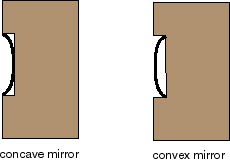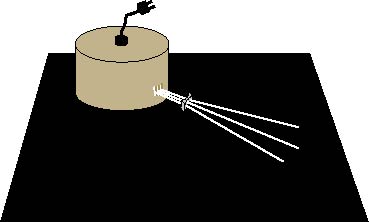
- What does the image look like?
- Is it inverted or upright? Why? (There is no lens.)
- What does this tell you about how light travels - in a straight line or not?
- Can you see near and far objects? How can both be "in focus"?
- How is a pinhole viewer similar to a person who squints to see better?
2-Dimensional Mirrors
- Cut a rectagular piece of plastic mirror, about 1 inch by 8 inches.
- Cut a rectangular piece (about 10 inches by 4 inches) of one-inch wood.
- Cut a rectangle out of one side. It should be smaller than the mirror.
- Bend the mirror as you force it into the cut-out piece.
- Bend it the opposite way to make a different curved mirror.

Cheap Light Box
- Obtain a round ice cream box from an ice cream store. (You want a round box, so the the edge is all equi-distant from the light in the center. If you use a rectangular box, the light rays won't be parallel.)
- Cut slits or make slits by taping popsicle sticks over an opening.
- Cut a hole in the top for the cord of a "showcase" light, which is a long, narror, clear light bulb. You can find them in hardware stores.
- Use lenses, mirrors (see 2-dimensional mirrors above), and colored filters.
- Be sure that the light is not close enough to the table to scorch or burn it. (I speak from experience!)
